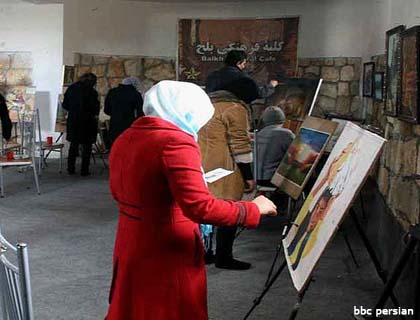The BBC Persian service ran a small but profoundly moving story on how a number of children and adolescents in Mazar-e Sharif experience with painting and drawing in "Balkh Cultural café". This is something that very few children in Afghanistan of today ever hear of or actually get the chance to do. What was deeply moving was the sheer contrast that the story portrayed.
The tenderness and delicateness of the world of children and adolescents of Afghanistan and the gentleness and innocence of what they drew and painted stood in a vicious contrast with all the violence and brutality that goes on all around them. To me, these children represent the proverbial 'green shoots', the flora and fauna amid an unsightly desert.
The world of children is all painted with peculiarities and beauties that make this period of life a colorful canvas of emotions and innocence. More interesting still is the period of adolescence; that magical period of transition when the person, at the threshold of adulthood, sets on an intriguing journey to re-discover (or better to say, discover) self and the world.
For any adolescent, this period is a crucial stage when the need for self-identification and self-actualization lead the person to experiment with various ways of letting out and expressing his reinforces sense of individuality and creativity. For some, sports and physical activity are comfortable and natural means of finding self and the world outside.
For many others, music, painting and drawing provide perfect means through which the anxious adolescent expresses his growing self-esteem and self-understanding. Painting and drawing, however, have a universal appeal; children and adolescents from any country and culture can be found in schools experimenting with their idea of themselves and the world around them.
My own fascination with painting and drawing during my childhood and adolescence knew no bounds. That was a world unto itself. Perhaps I was lucky to be in a family that could give me access to basic materials and colors to paint, draw. For countless Afghans, especially the generation whose childhood and adolescence happened to be when the country was mired in civil war and conflicts in the 1980s and 1990s, their experience of childhood and adolescence has been different.
For them, childhood and adolescence has been without even the very basic share of joy and expression of self-esteem and individuality through such things as painting and drawing. They have been raised being deprived of what the children of today and children and adolescents in other countries so routinely enjoy and live by.
Watching a children program on TV or sitting with other children and enjoying a session of drawings and paintings, taken for granted by many children of today, have been only a distant dream for an absolute majority of today's Afghan men. Perhaps, these are reasons that explain why violence and oppression are, today, indispensable parts of the men of Afghanistan. The origins of the war and conflicts of today and the prevailing, pervasive culture of violence so routine in today's Afghanistan can be traced to these broken childhoods and oppressed adolescences.
Perhaps the greatest humanitarian undertaking ever would be lessening the deprivation and mending the broken childhoods of the children. In very few places in the world children would be subjected to deprivation and violence more than in Afghanistan. Broken childhoods and oppressed adolescence remain very much the realities of life for the majority of children of Afghanistan today. The tenderness of the child's soul and heart are routinely brutalized and oppressed; his dreams and joys are shattered and his idea of being truly a child or an adolescent only a distant fable.
What is deeply unsettling is the fact that there are still millions of children in today's Afghanistan whose childhoods are still brutalized enslavements. They get to express no part of their maturing individuality and find no time and means to enjoy even the very basics of experimenting with arts, paints and colors. Countless childhoods are still being wasted and ruined and the end result is a world of tomorrow where violence is still the order of the day.
It would only be natural to see some of the grandeur and greatness of the erstwhile Balkh reclaimed and re-built. The old Balkh that was once the cradle of Bactrian civilization should see its rebirth. Nurturing the next generation of tomorrow and inculcating a sense of artistic appreciation in them are what would be the very first steps. Another would be to bring up the new generation of Afghan woman uninhibited and at ease with herself and the world around her; women who are unafraid of expressing themselves, their individuality and their art through their works and displaying them for the world to see.
Art and painting are still concepts that seem alien to Afghanistan. Amid a prevailing culture in which people fight for very survival and where violence has turned into a way of life for the majority of people (not only the Taliban), artistic self-expression is a rarity, an endeavor that people would only laugh at or frown upon.
The "Balkh Cultural Café" is certainly neither the first in its kind in Afghanistan nor the last. What is desperately needed is that more such cafes and classes be organized for Afghanistan's teeming children and adolescents to experiment for themselves in arts and self-expression. This would not give them a perfect childhood but at least would give them a chance to be one giant leap closer to being true children – splashing colors and paints and discovering themselves and their worlds.

